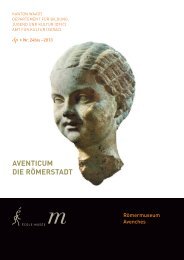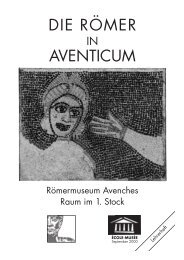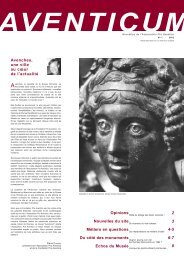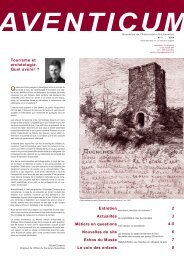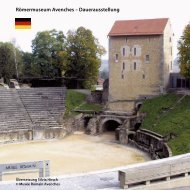Avenches – Roman Museum – Permanent Exhibition
Avenches – Roman Museum – Permanent Exhibition
Avenches – Roman Museum – Permanent Exhibition
You also want an ePaper? Increase the reach of your titles
YUMPU automatically turns print PDFs into web optimized ePapers that Google loves.
Second Floor Body and Health Care<br />
1-52. Fibulae (brooches) in bronze and silver.<br />
53. Man’s coat; fragment of a bronze statuette.<br />
54-55. Ivory box (copy) with bronze ring.<br />
56. Ivory jewellery (?) box.<br />
57-63. Boxwood bowl with faience beads and a bronze fibula.<br />
64-83. Bronze and bone hairpins.<br />
84. Gold earrings.<br />
85. Bronze necklace with small glass plaques.<br />
86-97. Amber, glass, crystal and jet beads.<br />
98-99. Bronze phallic charms.<br />
100. Silver pendant.<br />
101. Bronze coin, turned into a pendant.<br />
102. Gold necklace with blue glass beads.<br />
102-107. Jet and bronze bracelets.<br />
108-120. Silver, gold, iron, bronze and glass rings (1-2).<br />
121. Bronze statuette of a female dancer.<br />
Body and Health Care (3)<br />
(Display case 3)<br />
Gallo-<strong>Roman</strong>s liked to take care of their bodies. Since houses with running water<br />
were very rare, personal hygiene at home was kept to a minimum. More thorough<br />
personal hygiene was taken care of at public baths where one bathed, had<br />
unwanted hair removed, got a massage or took exercises. Aventicum had at least<br />
three public baths, the oldest dating from AD 29.<br />
Bad body odour was easily camouflaged by perfumes, which were preserved<br />
in small pottery, bronze or glass vessels (nos. 9-19). While the most expensive<br />
perfumes contained exotic products such as cinnamon or myrrh, rose and honey<br />
scents were much more common. Women liked to use make-up according to the<br />
fashion decreed by Rome: pale face, red lips, black eyebrows and painted eyelids.<br />
Various instruments were used to prepare, mix and apply the make-up (nos. 33 and<br />
34, 42-54).<br />
Throughout the entire <strong>Roman</strong> Empire, including Gaul, women always wore<br />
their hair long. Young girls tied it at the neck or plaited it while married women had<br />
more elaborate hairdos. Some even coloured their hair. Men often had their hair,<br />
beard and moustache styled the same as the reigning emperor. Most men went to a<br />
barber for a shave.<br />
Make-up and hairdos were checked with the help of small mirrors consisting<br />
of a polished bronze or silver plaque attached to a handle (nos. 5-7) or placed in a<br />
wooden frame (no. 55).<br />
1<br />
2<br />
3<br />
47<br />
Second Floor<br />
2<br />
3



